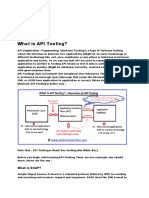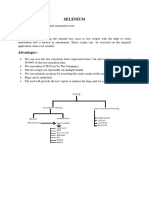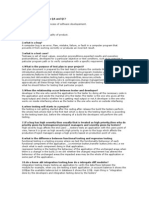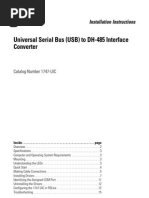Introduction To API Testing
Uploaded by
sulagnaIntroduction To API Testing
Uploaded by
sulagnaAPI Testing
What is API?
An API (Application Programming Interface) is a collection of software functions and procedures,
called API calls, that can be executed by other software applications.
What is API Testing?
API testing is mostly used for the system which has collection of API that needs to be tested. The
system could be system software, application software or libraries.
API testing is different from other testing types as GUI is rarely involved in API Testing. Even if GUI
is not involved in API testing, you still need to setup initial environment, invoke API with required
set of parameters and then finally analyze the result.
Setting initial environment become complex because GUI is not involved. In case of API, you need
to have some way to make sure that system is ready for testing.
This can be divided further in test environment setup and application setup. Things like database
should be configured, server should be started are related to test environment setup. On the other
hand object should be created before calling non static member of the class falls under application
specific setup.
Initial condition in API testing also involves creating conditions under which API will be called.
Probably, API can be called directly or it can be called because of some event or in response of
some exception.
Test Cases for API Testing:
The test cases on API testing are based on the output.
• Return value based on input condition
Relatively simple to test as input can be defined and results can be validated.
Example: It is very easy to write test cases for int add(int a, int b) kind of API. You can pass
different combinations of int a and int b and can validate these against known results.
• Does not return anything
Behavior of API on the system to be checked when there is no return value.
Example: A test case to delete(ListElement) function will probably require to validate size of
the list or absence of list element in the list.
• Trigger some other API/event/interrupt
The output of an API if triggers some event or raises some interrupt, then those
events and interrupt listeners should be tracked. The test suite should call
appropriate API and declarations should be on the interrupts and listener.
• Update data structure
This category is also similar to the API category which does not return anything.
Updating data structure will have some effect on the system and that should be
validated.
• Modify certain resources
If API call is modifies some resources, for example makes update on some database,
changes registry, kills some processes etc, then it should be validated by accessing
the respective resources.
API Testing vs. Unit Testing: What’s the difference?
1. API testing is not Unit testing. Unit testing is owned by development team and API by QE team.
API is mostly black box testing where as unit testing is essentially white box testing.
2. Both API-testing and unit-testing target the code-level, hence similar tools can be used for both
activities. There are several open source tools available for API testing and a few of them are
Webinject, Junit, XMLUNIT, HttpUnit, ANT etc.
3. API testing process involves testing the methods of .NET, JAVA, J2EE APIs for any valid, invalid,
and inappropriate inputs, and also testing the APIs on Application servers.
4. Unit testing activity is owned by the development team; and the developers are expected to
build Unit tests for each of their code modules (these are typically classes, functions, stored
procedures, or some other ‘atomic’ unit of code), and to ensure that each module passes its unit
tests before the code is included in a build. API testing, on the other hand, is owned by the QE
team, a staff other than the author of the code. API tests are often run after the build is ready, and
it is common that the authors of the tests do not have access to the source code; they essentially
create black box tests against an API rather than the traditional GUI.
5. Another key difference between API and Unit testing lies in the Test Case design. Unit tests are
typically designed to verify that each unit in isolation performs as it should. The scope of unit
testing often does not consider the system-level interactions of the various units. Whereas, API
testing, are designed to consider the ‘full’ functionality of the system, as it will be used by the end
user. This means that API tests must be far more extensive than unit tests, and take into
consideration the sorts of ‘scenarios’ that the API will be used for, which typically involve
interactions between several different modules within the application.
API Testing Approach
An approach to test the Product that contains an API.
Step I: Understand that API Testing is a testing activity that requires some coding and is usually
beyond the scope of what developers are expected to do. Testing team should own this activity.
Step II: Traditional testing techniques such as equivalence classes and boundary analysis are also
applicable to API Testing, so even if you are not too comfortable with coding, you can still design
good API tests.
Step III: It is almost impossible to test all possible scenarios that are possible to use with your
API. Hence, focus on the most likely scenarios, and also apply techniques like Soap Opera Testing
and Forced Error Testing using different data types and size to maximize the test coverage.
Main Challenges of API Testing can be divided into following categories.
• Parameter Selection
• Parameter combination
• Call sequencing
API Framework
The framework is more or less self-explanatory. The purpose of the config file is to hold all the
configurable components and their values for a particular test run. As a follow through, the
automated test cases should be represented in a ‘parse-able’ format in the config file. The script
should be highly ‘configurable’.
In the case of API Testing, it is not necessary to test every API in every test run ( the number of
API’s that are tested will lessen as testing progresses). Hence the config file should have sections
which detail which all API’s are “activated” for the particular run. Based on this, the test cases
should be picked up.
Since inserting the automation test case parameters into config file can be a tedious activity, it
should be designed in such a way that the test case can be left static with a mechanism of
‘activating’ and ‘deactivating’ them.
Definitions:
Soap Opera Testing: Soap opera tests exaggerate and complicate scenarios in the way that television soap
operas exaggerate and complicate real life.
Forced Error Testing: Forced error testing is nothing but mutation testing. It is process of inducing error /
changes to the application to find how application is working. The forced-error test (FET) consists of negative
test cases that are designed to force a program into error conditions. A list of all error messages that the
program issues should be generated. The list is used as a baseline for developing test cases.
Software Functions and Procedures: Functions and procedures are the foundations of programming. They
provide the structure to organize the program into logical units that can manage the various activities needed
for a program.
Functions
There are two basic types of functions:
Built-in—these are built into the programming environment and do things such as opening and closing files,
printing, writing, and converting variables (e.g., text to numbers, singles to integers, etc.).
Application/user-specific—depending on what the program needs, you can build functions and procedures
using built-in functions and procedures and variables.
Procedures
Procedures are used to perform a series of tasks. They usually include other procedures and functions within
the program.
Procedures typically do not return a value, they are simply executed and return control to the calling
procedure or subroutine.
Procedures in Visual Basic are called "Subroutines," often "Sub" for short. In JavaScript, "Functions" are used
as procedures (they simply return no or null values to whatever called them).
You might also like
- The Selenium Guidebook Java Edition 4.0.0No ratings yetThe Selenium Guidebook Java Edition 4.0.028 pages
- Real Life SCENARIO BASED Manual Testing Interview Question's and Answers PDFNo ratings yetReal Life SCENARIO BASED Manual Testing Interview Question's and Answers PDF15 pages
- Automated Software Testing Interview Questions You'll Most Likely Be AskedFrom EverandAutomated Software Testing Interview Questions You'll Most Likely Be AskedNo ratings yet
- Manual Testing Interview Question by Shammi Jha100% (7)Manual Testing Interview Question by Shammi Jha25 pages
- Api Testing: Presented By:-Prem Krishna Chettri0% (1)Api Testing: Presented By:-Prem Krishna Chettri12 pages
- Top 35 API Testing Interview Questions (2022) - JavatpointNo ratings yetTop 35 API Testing Interview Questions (2022) - Javatpoint12 pages
- Selenium Testing Tools Interview Questions You'll Most Likely Be Asked: Second EditionFrom EverandSelenium Testing Tools Interview Questions You'll Most Likely Be Asked: Second EditionNo ratings yet
- 2 Years Software Testing Resume Software TestingNo ratings yet2 Years Software Testing Resume Software Testing9 pages
- QAEngineer SQL, Manual Testing, Unix, QC, QTP, VB Scripting100% (2)QAEngineer SQL, Manual Testing, Unix, QC, QTP, VB Scripting3 pages
- API Automation Testing Training SyllabusNo ratings yetAPI Automation Testing Training Syllabus5 pages
- Selenium Notes by Satya Sir Ameerpet Hyd PDFNo ratings yetSelenium Notes by Satya Sir Ameerpet Hyd PDF398 pages
- Tester Interview Questions and Answers Are Completely Based On The Interview I and My Friends Attended During Last Years of Working Experience As Quality Assurance TestersNo ratings yetTester Interview Questions and Answers Are Completely Based On The Interview I and My Friends Attended During Last Years of Working Experience As Quality Assurance Testers10 pages
- Mobile Testing Interview Question & Answer100% (1)Mobile Testing Interview Question & Answer10 pages
- What Is Cucumber?: Why Use Cucumber With Selenium?No ratings yetWhat Is Cucumber?: Why Use Cucumber With Selenium?20 pages
- Manual Testing Questions & Answers: Infotech Providing Disciplined Software Testing PracticeNo ratings yetManual Testing Questions & Answers: Infotech Providing Disciplined Software Testing Practice25 pages
- Selenium Interview Questions: Guide to Crack Selenium Automation InterviewsFrom EverandSelenium Interview Questions: Guide to Crack Selenium Automation Interviews2.5/5 (3)
- Software Testing Interview Questions You'll Most Likely Be AskedFrom EverandSoftware Testing Interview Questions You'll Most Likely Be AskedNo ratings yet
- Java Core Interview in Australia. Questions and Answers. Tech interviewer’s notesFrom EverandJava Core Interview in Australia. Questions and Answers. Tech interviewer’s notesNo ratings yet
- What Is An API?: Set-Up of API Environment and Different Types of Test CasesNo ratings yetWhat Is An API?: Set-Up of API Environment and Different Types of Test Cases7 pages
- Mfx1200, Mfx1300, Mfx1600, Mfx1700 Service ManualNo ratings yetMfx1200, Mfx1300, Mfx1600, Mfx1700 Service Manual232 pages
- HPE MSA 2050,2052 Storage and Microsoft Windows Server 20160% (1)HPE MSA 2050,2052 Storage and Microsoft Windows Server 201663 pages
- Getting Up and Running With BDD On Rails: Nicholas Cancelliere Twitter: OzmoxNo ratings yetGetting Up and Running With BDD On Rails: Nicholas Cancelliere Twitter: Ozmox46 pages
- Cisco - IOS Tutorial - Cisco - Com - Small & Medium Business Solutions PDFNo ratings yetCisco - IOS Tutorial - Cisco - Com - Small & Medium Business Solutions PDF9 pages
- ManualPioneer (Deh 4350ub) (Deh 3350ub)No ratings yetManualPioneer (Deh 4350ub) (Deh 3350ub)72 pages
- Especificaciones Técnicas Equipos de RedNo ratings yetEspecificaciones Técnicas Equipos de Red7 pages
- Responder Action Policy Examples - New.generateallNo ratings yetResponder Action Policy Examples - New.generateall4 pages
- Power Modeling and Optimization For Ddr3 SdramNo ratings yetPower Modeling and Optimization For Ddr3 Sdram30 pages
- Background:: As An IT Auditor, One Should: Assist in Audit Engagement Planning and ReportingNo ratings yetBackground:: As An IT Auditor, One Should: Assist in Audit Engagement Planning and Reporting6 pages
- (Informatics Assistant) : Study MaterialNo ratings yet(Informatics Assistant) : Study Material18 pages
- DS-2CD1143G0-I 4.0 MP IR Network Dome Camera: Key FeaturesNo ratings yetDS-2CD1143G0-I 4.0 MP IR Network Dome Camera: Key Features4 pages
- Fixed Scenario Reception of DVB-T2 Signal in Urban Area: January 2013No ratings yetFixed Scenario Reception of DVB-T2 Signal in Urban Area: January 20137 pages
























































































